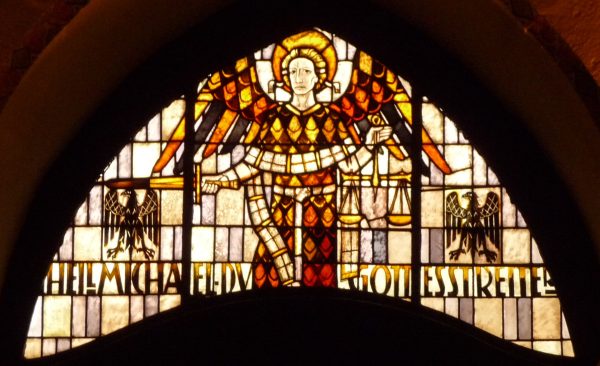As the year draws to an end and the holidays loom ever larger on the horizon, starting with Thanksgiving, I would like to talk about some big holidays in Europe that take place in autumn before we leave the season behind for the year. Two of these holidays are about two saints, St. Michael and St. Martin, both saints associated with soldiers and horses.
St. Michael’s feast day, better known as Michaelmas, is mostly referenced in older English novels, like the works of Jane Austen, when the celebrations of the holiday were fairly big. Full feasts and balls were given in honor of the day. Food such as goose and blackberries were the main focus of the meal, especially as blackberries were in their ripe season. An old legend states that after the feast of St. Michael, September twenty-ninth, the devil ruins the blackberries. More like they got mildewy and old, but saying the devil ruins them is more fun. And being the holiday that takes place not long after the autumn equinox, it was also the date when many people would pay their bills. Every quarter, the bills were due, so the closest holiday to the seasonal change was chosen for bill payment. But once that was done, the party commenced. Eating, dancing, games, the typical party fare, all proceeded by a Mass to commemorate the bravery of the angel who stood up to an angel greater than him for the love of God.
St. Martin’s feast day on November eleventh, or better known as Martinmas, was, at first, a strictly French holiday since St. Martin is one of the patrons of France. Then it spread to other parts of Europe and it became celebrated in a way quite similar to the way Americans celebrate Thanksgiving, as a kind of harvest festival. The typical feasting and merrymaking was involved along with Mass at the beginning of the day. And while St. Martin is associated with soldiers, since he was one, he is best remembered for cutting his cloak in half and giving it to a poor man. Later, the poor man is seen in his bed and is revealed to be Christ in disguise, thanking him for the kindness. Martin leaves the military not long after that and becomes a priest, eventually becoming bishop of Tours and later patron of all of France.
While many do not associate the first half of December with being still in autumn, it technically is since the first day of winter isn’t until December twenty-first. As such, these next two holidays are still considered autumnal holidays.
The first is the feast of St. Nicholas, celebrated on December sixth. The Turkish saint behind the legend of Santa Claus is claimed by people who celebrate his feast that the saint delivers presents on his feast day rather than on Christmas. The reason why he became such a large character in the Christmas sphere was because of a legend that he helped three young women and their father in a time of need. When he grew up he became a priest, and then a bishop, and continued his generosity. After his passing, the legend spread to other parts of the world, where they eventually got mixed up with traditional Father Christmas/Winter imagery, eventually becoming the Santa Claus we know today.
The final feast day, that takes place on December thirteenth, belongs to St. Lucy, a fan favorite of the Northerners, specifically Sweden and Norway. They celebrate her feast with one of the daughters (typically the eldest) dressing up in a white dress, a red sash, and a wreath crown with lit candles. She serves the family coffee and baked goods such as saffron bread and ginger biscuits to commemorate the girl martyr so closely associated with eyes. This is because, according to legend, her eyes were destroyed as part of her torture, but God gave her back the use of her sight, converting several people to the faith. But eventually her persecutors did martyr her, and many celebrate her loyalty to God by observing her feast day.
These are just the four biggest feast days celebrated in the autumn, next to All Saints day, or Hallowmas or Hallowtide for the three day holiday. There are others, like St. Francis of Assissi and St. Therese of Lisieux in October, which holds some significance on the calendar, but aren’t quite as big of celebrations as the four listed. Most countries have their own saints that they celebrate the feasts of that not many others, if any, do catch on and celebrate as well. As such, you will find the big celebration of certain feasts only in one country or another, while others are celebrated around the world due to immigration. Which is the beauty of cultures sharing and growing together as we walk into the future.
Cover Photo by Warburg/Wikimedia Commons

Thank you!